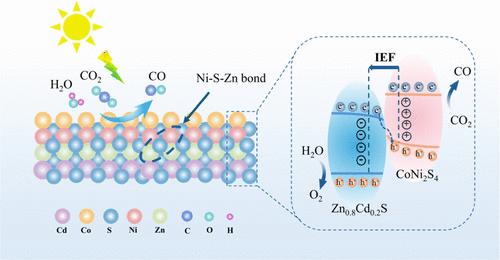Ni-S-Zn键增强CoNi2S4/Zn0.8Cd0.2S S-Scheme异质结增强CO2光还原
IF 3.9
3区 工程技术
Q2 ENGINEERING, CHEMICAL
引用次数: 0
摘要
光催化CO2转化被认为是通过产生可持续燃料来解决能源相关和生态问题的有效策略。在此,我们通过原位硫化方法构建了CoNi2S4/Zn0.8Cd0.2S S-scheme异质结。通过密度泛函理论计算和实验研究,我们证明了电子从CoNi2S4转移到Zn0.8Cd0.2S建立了一个从CoNi2S4指向Zn0.8Cd0.2S的内部电场(IEF)。原位x射线光电子能谱和开尔文探针力显微镜分析表明,IEF促进了光致电子通过界面Ni-S-Zn键的迁移,从而验证了s型异质结的建立,显著提高了电荷分离效率。优化后的异质结具有优异的CO2光还原性能,CO产率为3.60 μmol g-1 h-1,分别是CoNi2S4 (0.40 μmol g-1 h-1)和Zn0.8Cd0.2S (0.73 μmol g-1 h-1)的9.0和4.9倍。该研究为设计高效CO2光还原的高性能金属硫化物s型异质结提供了重要见解。本文章由计算机程序翻译,如有差异,请以英文原文为准。

Interfacial Ni–S–Zn Bond-Reinforced CoNi2S4/Zn0.8Cd0.2S S-Scheme Heterojunction for Enhanced CO2 Photoreduction
Photocatalytic CO2 conversion is regarded as an effective strategy to tackle energy-related and ecological issues by generating sustainable fuels. Herein, we develop CoNi2S4/Zn0.8Cd0.2S S-scheme heterojunctions constructed via an in situ sulfurization approach. Through combined density functional theory calculations and experimental investigations, we demonstrate that electron transfer from CoNi2S4 to Zn0.8Cd0.2S establishes an internal electric field (IEF) directed from CoNi2S4 to Zn0.8Cd0.2S. Both in situ X-ray photoelectron spectroscopy and Kelvin probe force microscopy analyses demonstrate that the IEF promotes the migration of photoinduced electrons via interfacial Ni–S–Zn bonds, thereby verifying the establishment of an S-scheme heterojunction that markedly improves charge separation efficiency. The optimized heterojunction exhibits exceptional CO2 photoreduction performance, accomplishing a CO yield rate of 3.60 μmol g–1 h–1, which is 9.0 and 4.9 times higher than those of the original state CoNi2S4 (0.40 μmol g–1 h–1) and Zn0.8Cd0.2S (0.73 μmol g–1 h–1), respectively. This study provides critical insights for designing high-performance metal sulfide-based S-scheme heterojunctions toward efficient CO2 photoreduction.
求助全文
通过发布文献求助,成功后即可免费获取论文全文。
去求助
来源期刊

Industrial & Engineering Chemistry Research
工程技术-工程:化工
CiteScore
7.40
自引率
7.10%
发文量
1467
审稿时长
2.8 months
期刊介绍:
ndustrial & Engineering Chemistry, with variations in title and format, has been published since 1909 by the American Chemical Society. Industrial & Engineering Chemistry Research is a weekly publication that reports industrial and academic research in the broad fields of applied chemistry and chemical engineering with special focus on fundamentals, processes, and products.
 求助内容:
求助内容: 应助结果提醒方式:
应助结果提醒方式:


